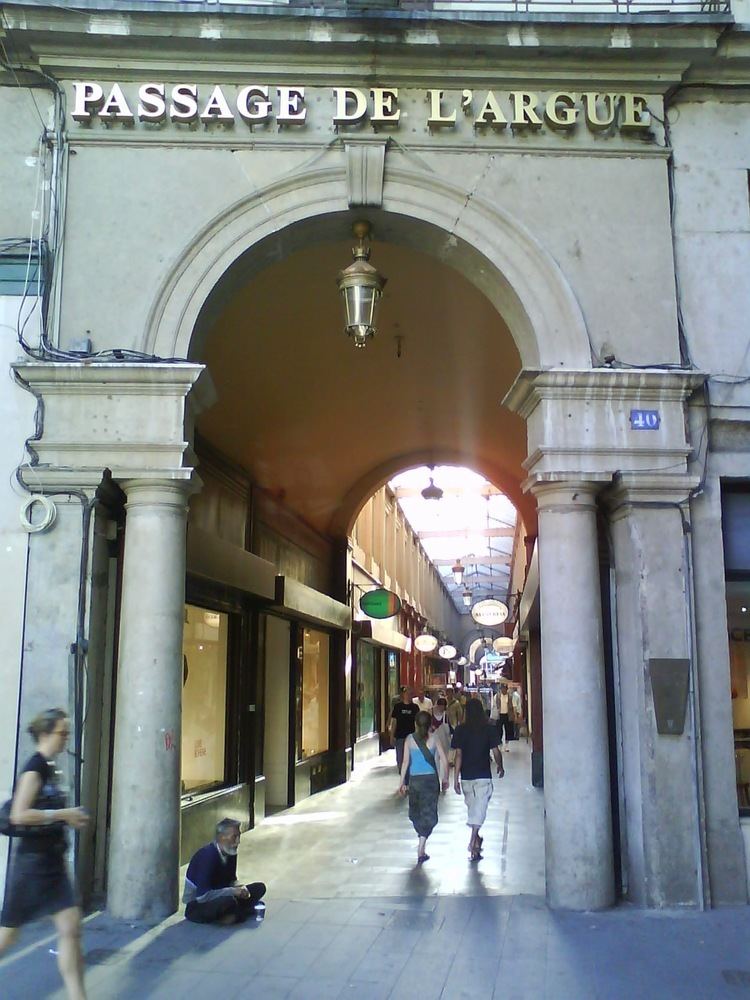Inauguration 1828 Inaugurated 1828 Architect Vincent Farge | Postal code 69002 Construction started 1825 | |
 | ||
Similar Place des Jacobins, Saint‑Nizier Church, Place Bellecour, Église Saint‑Bonaventure, Palais de la Bourse - Lyon | ||
The Passage de l'Argue is a covered hall located in the Bellecour quarter, in the 2nd arrondissement of Lyon, which connects the rue de la République to the rue Édouard-Herriot and the rue de Brest. This is one of the oldest arcades in the French provinces, built on the same model as the Parisian ones of which it is contemporary. Famous and of wealthy repute in Lyon, it plays a significant role in the trade of the Presqu'île. There is also the Petit Passage de l'Argue, which formed a part of the main Passage de l'Argue before the Rue de Brest intersected it. To access it, one need only cross the road.
Contents
Map of Passage de l'Argue, 69002 Lyon, France
History
The word "argue" (from Greek arguros which means "silver" in English) refers to the wire drawing machine for gold and silver bullions used for weaving. To prevent counterfeiting, there were two offices of silver, one in Paris, another in Lyon, located in the rue de la Monnaie, near the Passage de l'Argue.
The passage was already mentioned on the city map made in 1740 by Claude Séraucourt, but was then an unhealthy narrow street composed of fifteen workshops of weaving. There was also a monetary workshop which was abolished in the late 18th century, but restored by the French Directory in 1798. The old houses were bought and demolished by M. Coste, Casati, Dugueyt, and Millon to do rebuilt the passage in 1825 by architect Fargue and opened three years later. In 1834, the Republicans were hidden in the passage and this latter was completely ransacked: broken windows, destroyed stores and looted goods... In November 1840, the passage was completely flooded after heavy rains.
Although it was uncommon at the time, gas lighting was brought very quickly: indeed, in October 1828, Delorme requested the installation of a gasometer in the passage and the gas used to illuminate was prepared in the workshop located in the rue Tupin-Rompu. Moreover, the lighting and maintenance of the paving stone of the passage was generously provided by the city of Lyon. The auction sale was prohibited in the hall by an order of 1828.
The passage housed many notable buildings. There was the Atelier de l'Argue, which was removed in the late sixteenth century and restored by a decree on 15 May 1798; it was finally traded to the rue de la Savoie thereafter. On 2 March 1828, civil and military authorities participated in the inauguration of the Café-Théâtre owned by Seguin. This theater had a circular room, two Corinthian and Ionic columns with two rich entablatures, and rich and elegant ceiling, chandelier and ornaments. However, despite a large attendance, the theater closed due to bankruptcy. In 1836, a renowned restaurant, headed by Caillot, then in 1960, the Théâtre des Bouffes Lyonnaises, were opened. In 1862, Louis Josserand and his wife Gabrielle Avocat opened a theater of Guignol and, in 1899, this puppet gave shows in the Petit Passage de l'Argue, near the hall.
Among famous people who lived in this passage, there were painters Julian Gubian (1834) and Perignon (1840).
Architecture and monuments
In 1836, the passage had 96 arches with uniform closures. The northern part was composed of two high airy floors, and the southern part had only one floor until the rotunda. As for the entrance, it was formed by an arc whose archivolt is supported by Doric columns.
This hall represents a particular style of architecture in Lyon and resembles that of Italian galleries in Rome or Milan. Although cut in two parts by the Rue Édouard-Herriot under the Second Empire, this passage retains its decorative and constructive authenticity.
The four façades are decorated and the passage is covered by glass walls. In the interior, there are lanterns and shop signs are made of rounded metal the shops frames are in wood.
The hall is composed of shops of all types in which mainly luxury items, including watches, pipes or bags, can be bought.
On the central rotunda, four small statues of the Roman god protector of merchants and travelers Mercury with winged feet, based on an Italian work of Renaissance style, were successively erected, but not exactly at the same place. The statue was first stolen in 1902, notably removed during the Second World War, stolen again three days after its inauguration in April 1995, and eventually reinstalled in October 1996. The third copy of the statue was the work of Giambologna. Until 2011, the plinth lay empty before playing host to an unofficial installation of modern art-street graffiti from the creator of "Birdy Kidz", which was subsequently removed some months later.
Reception
The passage became very luxuous throughout years and achieved notability. Due to its architecture, it was immediately welcomed as proved by the fact that, according to some sources, the two-thirds of its stores were already rented before its opening. Many laudatory statements were made about it; for example, it was described as "a place of refuge, walk for winter evenings and rainy days, and an embellissement as well as a convenience for the entire population of the city"; it was considered as a "regeneration" for the quarter, and has the same "charm" as the Parisian passages.
